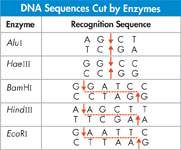What is an SNP (single nucleotide polymorphism)?
What is bioinformatics?
Think Critically
Draw Conclusions Scientists have searched the human genome database to find possible promoter sequences. What is likely to be found near a promoter sequence?
Infer Why does DNA move toward the positive end of the gel during gel electrophoresis?
Observe The table below shows the DNA sequences that are recognized by five different restriction enzymes and the locations where those enzymes cut. Which enzymes produce DNA fragments with “sticky ends”? What is the common feature of the sequences cut by these enzymes?
Connecting Concepts
Use Science Graphics
Use the data table to answer questions 27 and 28.
Interpret Tables What differs in the sex-determining mechanism of the two organisms?
28. Draw Conclusions What can you logically conclude about the genes on the sex chromosomes of fruit flies and humans?
Write About Science
Explanation Write a paragraph that tells how colorblindness is inherited. Describe the condition and explain why it is much more common in males. (Hint: Begin your paragraph with a topic sentence that expresses the paragraph's main idea.)
Assess the
 Explain the relationship between meiosis and Down syndrome, Turner's syndrome, and Klinefelter's syndrome.
Explain the relationship between meiosis and Down syndrome, Turner's syndrome, and Klinefelter's syndrome.
Analyzing Data
Hemophilia is an example of a sex-linked disorder. Two genes carried on the X chromosome help control blood clotting. A recessive allele in either of these two genes may produce hemophilia. The pedigree shows the transmission of hemophilia through three generations of a family.
Interpret Diagrams Which mothers are definite carriers of the gene?
Apply Concepts Why did the sons of Person 3 not inherit the trait?
Apply Concepts How could Person 12 have hemophilia if neither of his parents had hemophilia?
Table of Contents
- Formulas and Equations
- Applying Formulas and Equations
- Mean, Median, and Mode
- Estimation
- Using Measurements in Calculations
- Effects of Measurement Errors
- Accuracy
- Precision
- Comparing Accuracy and Precision
- Significant Figures
- Calculating With Significant Figures
- Scientific Notation
- Calculating With Scientific Notation
- Dimensional Analysis
- Applying Dimensional Analysis







